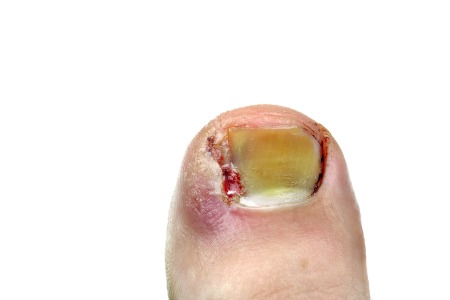What is an ingrowing toenail?
An ingrowing toenail is where a piece of nail pierces the flesh of the toe. It can feel as if you have a splinter, be extremely painful and inflamed or infected. In more severe cases, it can cause pus and bleeding. Ingrowing toenails most commonly affect the big toenail, but can affect the other toes too. A nail that is curling (involuted or convoluted) into the flesh, but isn’t actually piercing the skin, isn't an ingrowing toenail but can feel very painful and can also appear red and inflamed.
What causes it?
There are many genetic factors that can make you prone to ingrowing toenails, including your posture (the way you stand), your gait (the way you walk) and any foot deformity such as a bunion, hammer toes or excessive pronation of the feet (when your foot rolls inward excessively). Your nails may also have a natural tendency to splay or curl out instead of growing straight, encouraging your nail to grow outwards or inwards into the flesh.
One of the most common causes is not cutting your toenails properly, such as cutting nails too low in order to relieve the pressure and discomfort of an involuted nail.
Tight footwear, hosiery and socks can also push your toe flesh onto the nail so that it pierces the skin. Also, if you sweat excessively or don’t rotate your footwear, this makes the skin moist and weak so that it is easily penetrated by the nail. If you have brittle nails with sharp edges or are in the habit of breaking off bits of nail that are sticking out, you are also more likely to get an ingrowing toenail.
Who gets it?
Active, sporty people are particularly prone, because they sweat more. Younger people are more likely to get it (as they pick their nails more, compared to older people who may not be able to reach their toes!).
How do I know I have it?
The most common symptom is pain followed by inflammation in the surrounding nail area.
However, not everyone identifies an ingrowing toenail correctly. Sometimes, they have a curly nail which has a lot of debris (dirt or fluff) underneath it or a corn or callus down the side of the nail, which can be nearly as painful. However, if it’s a corn, the pain tends to be throbbing as opposed to the sharp pain you get with an ingrowing toenail. If this is the case, your podiatrist will remove the debris, and, if necessary, thin the nail.
Is it serious?
Not usually, unless you have an existing condition such as diabetes, poor circulation or a reduced immune system. However, if left untreated, infection could develop in the rest of the toe and foot and in very rare cases could get into the blood stream. The quicker you deal with it, the less painful the treatment.
What are the treatments?
Before you are seen by a podiatrist, you can relieve the discomfort by bathing your foot in a salty footbath, which helps to prevent infection and reduces inflammation. Then apply a clean sterile dressing, especially if you have a discharge, and rest your foot as much as possible.
How a podiatrist will treat you will depend largely on the severity of your condition:
How can I prevent it?
Firstly, learn to cut your nails properly. Nail cutters aren’t a good idea because the curved cutting edge can cut the flesh and nail scissors can slip. It’s best to use nail nippers (available from chemists) because they have a smaller cutting blade but a longer handle. Cut your nails straight across and don’t cut too low at the edge or down the side. The corner of the nail should be visible above the skin. Also, cut them after a bath or shower when the nail is much softer.
Good hygiene can go a long way to preventing ingrowing toenails. Avoid moist, soggy feet by letting rotating your footwear so each pair has a chance to dry out thoroughly. Avoid man-made materials (synthetics) and choose socks and shoes of natural fibre and which fit properly. Keep your feet clean and dry and in the summer and wear open-toed sandals to let air get to your toes as much as possible.
If you have diabetes, are taking steroids or are on anti-coagulants, don’t attempt to cut your nails or remove an ingrowing spikes of nail yourself.
When should I see a podiatrist?
You should see a podiatrist urgently if you have symptoms of infection, and also have diabetes, poor circulation or a reduced immune system. You should also visit a podiatrist if you experience any persistent pain in your toe from the ingrowing nail or have a condition that affects the nerves and/or feeling in your foot.
If you experience any foot care issues that do not resolve themselves naturally or through routine foot care within three weeks, it is recommended that you seek the help of a healthcare professional.
To talk to a podiatrist (also known as a chiropodist) about the options available regarding treatment, you can contact an NHS podiatrist or a private practice podiatrist. In both cases, always ensure that any practitioners you visit are registered with the Health and Care Professionals Council (HCPC) and describe themselves as a podiatrist (or chiropodist
